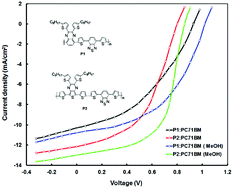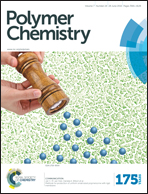Synthesis of alternating D–A1–D–A2 terpolymers comprising two electron-deficient moieties, quinoxaline and benzothiadiazole units for photovoltaic applications†
Abstract
Two new regular (D–A1–D–A2) terpolymers P1 and P2 containing two electron-deficient moieties, quinoxaline and benzothiadiazole, were designed and synthesized. The resulting copolymers exhibit high thermal stability, broad absorption in the range of 300 to 950 nm, low Eg of both 1.36 and 1.57 eV, as well as deep HOMO energy levels of −5.24 and −5.62 eV. Such properties are useful in improving photovoltaic properties. Polymer solar cells (PSCs) based on optimized P1:PC71BM and P2:PC71BM (1 : 2 by weight) active layers with a 3 v% DIO/CF additive displayed a power conversion efficiency (PCE) of 5.28% (Voc of 0.93 V, Jsc of 10.28 mA cm−2 and FF of 0.55) and 5.54% (Voc of 0.80 V, Jsc of 12.18 mA cm−2 and FF of 0.57), respectively, under illumination of AM1.5G (100 mW cm−2). In order to increase the PCE further, the DIO/CF processed active layer was subjected to methanol treatment that resulted in a PCE increase up to 7.13% and 7.59% for the P1:PC71BM and P2:PC71BM based devices, respectively. The methanol treatment increases all of the photovoltaic parameters, which is attributed to the lowering of series resistance, an increase of hole mobility, and reduction of charge recombination due to enlarged built-in potential.


 Please wait while we load your content...
Please wait while we load your content...